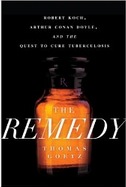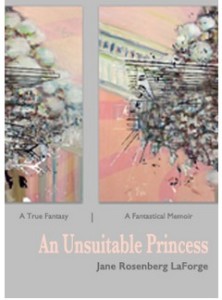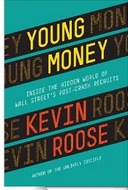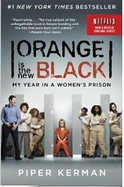The Remedy
 What do Sherlock Holmes and Tuberculosis have in common? Thomas Goetz’s The Remedy aims to answer that question.
What do Sherlock Holmes and Tuberculosis have in common? Thomas Goetz’s The Remedy aims to answer that question.
From the publisher summary:
Imagine this: it’s 1875 and you or a loved one has just been diagnosed with tuberculosis (TB). At a time when doctors had little in their arsenal for treating the disease and were even less certain about what caused it, TB was a death sentence.
But a scientific revolution was brewing. Robert Koch, a country doctor, was fascinated by the emerging field of microbiology, and through obsessive and careful experimentation, he began isolating and identifying germs and eventually made the discovery that would change his life: he found the germ that caused tuberculosis. He quickly turned his skills to finding a cure, and when he announced his success, people arrived in droves to try his remedy.
One of the visitors was Arthur Conan Doyle, then a doctor and sometime writer and a great admirer of the scientific method that Koch helped establish. When Conan Doyle toured the wards of patients, though, he was horrified – Koch’s remedy was either sloppy science or outright fraud. This remedy would become Koch’s most tragic disgrace, but it would also give us the most enduring literary detective of our times, one who did more than any scientist to popularize science.
The Remedy is a fascinating read. It’s hard to fathom a time when germs were not known or understood, when sanitation in hospitals is nothing like it is now, but it wasn’t all that long ago. The Remedy goes into deep detail of the works of Louis Pasteur and Robert Koch, scientific rivals, who helped develop the scientific method and illustrate cause of specific diseases- which led to ways to vaccinate against them or treat them. The results of their work are still impacting us today. Enter in Arthur Conan Doyle, a doctor and author, who uses the scientific method to create one of the most beloved literary characters of all time AND uses his own knowledge to debunk one of the era’s preeminent scientists, and you have one interesting read.
What I didn’t realize before reading The Remedy was how competitive the scientific arena was at the time- and presumably still is. I also didn’t realize the thrall of Sherlock Holmes on the public from its initial publication. Both of those things made the book quite interesting. I enjoyed the science behind the story. It’s just enough to give the reader a good explanation of the challenges, experimental process, and findings without getting into too much technical detail that could be overwhelming to some people.
Goetz’s writing is easy to read, his approach matter-of-fact and his observations of the habits of the time only add to the story. His glimpses of the “snake oil” remedies around make me grateful for the medicine we have today.
Fans of non-fiction should check this out. So should Sherlock fans. You get a bit of insight into how Doyle came to the stories and his own feelings about his venerable hero- in fact, after reading The Remedy I may finally pick up a Sherlock Holmes book to read.
**** I received an Advance Copy of this book from the publisher in exchange for an honest review****
An Unsuitable Princess

The subtitle to Jane Rosenberg LaForge’s novel An Unsuitable Princess is A True Fantasy/A Fantastical Memoir. From the publisher’s description:
An Unsuitable Princess: The Story
Fantasy and memoir, contemporary and Renaissance times all converge in this duo of simultaneously-narrated tales. In the first, set in Renaissance England, a mute stable girl with mysterious healing powers has been inexplicably declared an outcast by the Queen. Rumored to be a witch, she is relegated to living in a barn with no hope for friendship or family. Yet those who know her — including a young man whose family raised her as their daughter and whose life she saved — fall inexorably in love with her gentle and seemingly magical ways. The second tale, told as a series of footnotes to the first, is a memoir of the author’s coming-of-age in L.A. in the 1970s where she’s an awkward, self-absorbed adolescent struggling to define herself amid Hollywood’s eclectic population of hippies, mid-list celebrities, drug addicts and suburbanites. It’s also a provocative reflection upon the author’s inspiration for the book’s Renaissance storyline, stemming from the guilt she’s harbored over the death of a high school sweetheart — as well as a sophisticated commentary on society and its values, the absurdity of our obsessions and how we too often fail to see the world around us.
Together the book’s dual stories leave readers to ponder the fine line between reality and the living fairy tales we weave in pursuit of happy endings.
I found myself at times wanting this one book to be two. I wanted Jane’s story told all at once, and then I wanted to know all of Jenny’s story. But weaving the two stories together makes for an intriguing concept and the more I read in the book, the faster I read, wanting to see how the stories might converge. I got sucked into both the stories, and was especially struck by the introspection in the memoir. It’s the kind of self exploration that comes from age and perspective and the distance of time.
Word choices in the book are sometimes lofty, true vocabulary words, but I do not find that off-putting.
My criticisms of the book are few. I wish I knew more about some of the characters- that we needed a bit more backstory that we may have had if each story had been a separate book. I also feel that resolution to one story came a bit too easily. I would have liked to see more about that particular relationship, although it is given closure. I don’t know. Maybe I’m asking for it to be more melodramatic than it really needs to be.
At any rate, the concept here is quirky and interesting. It works. I ended up with both an electronic and physical copy of the book. From a readability perspective, alternating between the stories, I found the physical book to be easier to read than the eBook. If you’re a fan of memoirs and open to something that is conceptually different, this is one that I urge you to check out.
***I received a copy of the book in exchange for an honest review.***
A bit about the author:
To Everything
To Everything There is a Season… that’s been running through my head a lot lately. After all my talk and plans earlier this year to post more frequently, life went and did its own thing, as it is prone to do, and here I am weeks without publishing anything.
Without going into too much detail, at least for now, in early April, my mother got some strange results from the doctor after not feeling well over a weekend. Fast forward roughly five weeks, on Friday, we got confirmation of a secondary adenocarcinoma of the liver, which is a fancy way of saying she has cancer in her liver but it didn’t start there. Any time cancer moves from a primary source into other organs, it’s automatically Stage IV, serious stuff. This situation is complicated by an inability to determine the exact source, which means we are waiting on some additional test results to see if we can sort that out, and then determine treatment options.
So, between work and traveling to my mom’s, and tests, and doctor visits, and bringing her to my city for additional tests and doctor visits, reading fell off the table a bit. Consequently, so did blogging. I’m so far behind and I sincerely appreciate the patience of publishers and authors who have understood that I have had to shift schedules for a bit.
But I’m back- two posts will be coming up this week. Two very different books, but I’ve enjoyed them both, and I can’t wait to share them with you.
Young Money
 Kevin Roose’s The Unlikely Disciple was the very first book I reviewed when I started TheBookFetishBlog. I liked his style and so was glad to pick up Young Money when it was released just a few weeks ago.
Kevin Roose’s The Unlikely Disciple was the very first book I reviewed when I started TheBookFetishBlog. I liked his style and so was glad to pick up Young Money when it was released just a few weeks ago.
From the book description:
Becoming a young Wall Street banker is like pledging the world’s most lucrative and soul-crushing fraternity. Every year, thousands of eager college graduates are hired by the world’s financial giants, where they’re taught the secrets of making obscene amounts of money– as well as how to dress, talk, date, drink, and schmooze like real financiers.
YOUNG MONEY
Inside the Hidden World of Wall Street’s Post-Crash Recruits
YOUNG MONEY is the inside story of this well-guarded world. Kevin Roose, New York magazine business writer and author of the critically acclaimed The Unlikely Disciple, spent more than three years shadowing eight entry-level workers at Goldman Sachs, Bank of America Merrill Lynch, and other leading investment firms. Roose chronicled their triumphs and disappointments, their million-dollar trades and runaway Excel spreadsheets, and got an unprecedented (and unauthorized) glimpse of the financial world’s initiation process.
Roose’s young bankers are exposed to the exhausting workloads, huge bonuses, and recreational drugs that have always characterized Wall Street life. But they experience something new, too: an industry forever changed by the massive financial collapse of 2008. And as they get their Wall Street educations, they face hard questions about morality, prestige, and the value of their work.
YOUNG MONEY is more than an exposé of excess; it’s the story of how the financial crisis changed a generation-and remade Wall Street from the bottom up.
When I started reading Young Money, I got the same feeling as I did the first (and only) time I watched the movie “Up In The Air”: my chest tightened, my shoulders hunched, and my breathing shallowed. In other words, it stressed me out. The first years of a Wall Street Analyst sound eerily familiar to my days as a road warrior for a Big Five (at the time) consulting company.
Fortunately, I was able to take a few deep breaths and get some perspective. That world is long behind me now, thankfully. But Roose provides some real food for thought as he delves into the work and personal lives of these analysts. Young Money starts just after the bailouts of 2008, when Wall Street was reeling, and people were spewing vitriol about the Street and all it stands far. Some of these kids took jobs in finance to set the foundation for a potentially lucrative career. Others took it solely as a stepping stone, a temporary detour from what they really want to do. Two years on the Street at the right investment bank and they can write their ticket. None realized how soul-sucking the work could be. And while they may have thrived temporarily on the adrenaline, most of them paid big tolls in their personal lives, and with potentially devastating impacts to their mental and physical health.
At the same time, some of them struggled with the ethics of the high finance world- is making money truly the most important thing, or do these companies bear some ethical responsibility to actually help people? Or, at a minimum, understand how their actions impact others? Some were able to see the benefits of working on Wall Street. Others decided that with the deflated payoffs of working on Wall Street that sacrifices- excruciatingly long workdays; the lack of weekends, holidays, and vacations; the broken relationships- just weren’t worth it.
While it may problem most prevalent on Wall Street, I think many people just starting out in their careers question what they are doing. And it was this self analysis and instinct for self- preservation in the analysts that made the biggest impact in the book. Roose shows not only the dark side of this world, but also the introspection of the people who allowed him into their lives. And he does it in a compassionate way, clearly concerned about whether or not they will all survive the two year hell period no worse for the wear.
Aside from the looks into the lives of the analysts, Roose also details his night crashing a dinner of the Wall Street elite. Reading it is cringe-inducing. Not because of the writing, but because of the mentality, actions, and words of the dinner attendees. It exposes a truly seedy underbelly of the Wall Street World and should cause every attendee to think twice.
While Roose’s writing is seen more frequently in New York magazine and on Daily Intelligencer, it’s good to see a second book from him. I’m looking forward to number three.
Orange Is The New Black
 I enjoy the Netflix series “Orange Is The New Black” but the best thing I can say about Piper Kerman’s memoir Orange Is The New Black is that it bears little semblance to the series.
I enjoy the Netflix series “Orange Is The New Black” but the best thing I can say about Piper Kerman’s memoir Orange Is The New Black is that it bears little semblance to the series.
One of my favorite things about the TV series is that we get the backstories of the other prisoners. We get very little of that in the memoir. But what we do get in the memoir is to me, in many ways, much more telling and engaging.
A co-worker read Orange Is The New Black at the same time I did, and it was my book club’s February selection. Overwhelmingly, we all said the humanness presented in the memoir was the thing we liked most about it. The memoir makes clear some of the challenges of the US Justice System- the seemingly arbitrary and sometimes excessively long lock-up times for non-violent crimes. The absolute loss of power for a prisoner with sometimes-unscrupulous corrections officers. The woefully inadequate re-entry preparation the justice system provides for inmates about to be released. Imagine entering prison before the Internet was in seemingly every household and leaving in the age of the iPhone. Without a strong support structure in place, it is a recipe for failure- and repeat offenses.
The most poignant part of Kerman’s memoir is her realization of the impact of her actions. Not only on her friends and family and what her incarceration did to them, but also what the drug trade is doing to communities and families throughout the country.
Kerman owes a debt of gratitude to the support system she had in place while she served her sentence. She had the unwavering support of her family and her now-husband and numerous friends. That support was critical to her mental health while inside and so much stronger than what many other prisoners face.
Although it is rather slow paced, I enjoyed the memoir in many ways much more than the series. And for those who may be put off by the salaciousness of the series, there is none of that in the book. Instead, it’s a personal story of a person dealing with the consequences of her actions, and what she learned about life, others, and herself in the process.
- 0 Comments
- Tags: Memoir, non-fiction
